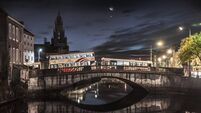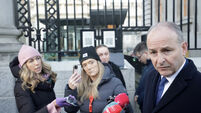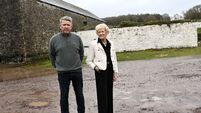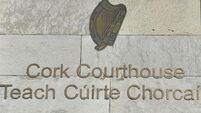A fallen empire
Soviet army tanks are parked near the Spassky Gate, an entrance to the Kremlin, after an attempted coup against Mikhail Gorbachev (inset) in 1991, a coup that hastened the decline of the USSR. Gorbachev was respected abroad for his attempts to reform the USSR but at home he was perceived to be the destroyer of the former Soviet Union. Pictures: Getty
TWENTY years ago this month the largest country in the world broke up into 15 states. When Mikhail Gorbachev resigned as president of the USSR on Christmas Day 1991 it signalled the end of the multinational Soviet state ruled by communists for 70 years and the disintegration of the Eurasian empire constructed by their tsarist predecessors.
The biggest of the Soviet successor states was the Russian Federation with a population of nearly 150 million, followed by the Ukraine (52 million), Uzbekistan (20 million), Kazakhstan (16.5 million), Belarus (10 million), Azerbaijan (7 million), Georgia (5.5 million), Tajikistan (5 million), Moldova (4.5 million), Kyrgystan (4 million), Turkmenistan (3.5 million), Lithuania (3.5 million), Armenia (3 million), Latvia (2.5 million) and Estonia (1.5 million).
The Soviet experiment in socialism begun by the Bolsheviks when they seized power in Russia in 1917 had failed. Above all, the disintegration of the USSR into its constituent national republics demonstrated the power of nationalism — or rather the power of the nationalist movements that seized control as the Soviet federal state collapsed.
The break-up of the USSR was surprisingly unshocking, coming as it did in the wake of a series of equally dramatic developments: Gorbachev’s democratisation of the authoritarian communist political system; the breaching of the Berlin wall and the reunification of Germany; the fall of communism in Eastern Europe; the ending of the Cold War; and the attempted coup against Gorbachev in August 1991.
The story of this astounding sequence of events began with Gorbachev’s appointment as leader of the Soviet Communist Party in March 1985. Gorbachev was a radical reformer and his catchwords were glasnost — the opening up of the Soviet political system — and perestroika — the reform of the Soviet socialist economy by the introduction of market forces that would make it more dynamic and responsive to consumer demands.
The aim of Gorbachev’s reform programme was to revitalise the Soviet communist system, not to destroy it. However, during the course of his reforms Gorbachev himself became convinced that communism should be replaced by a version of the liberal social democratic system prevalent in the Western world, including in Ireland. However, he remained committed to the continuation of the Soviet Union as a multinational federal state.
The problem was that Gorbachev’s democratic reforms unleashed political forces that challenged not just communism but the continuation of the USSR. This development was particularly marked in the Baltic republics of Estonia, Latvia and Lithuania, which had been forcibly and violently incorporated into the USSR in 1940 under the auspices of the Stalin-Hitler pact that divided Eastern Europe into Soviet and German spheres of influence. Ethnic identities and nationalist memories were still strong in the Baltic states and a substantial movement for independence developed in the late 1980s.
There were also strong nationalist movements in Georgia and the Ukraine while in other parts of the USSR — in Kazakhstan, Armenia, Azerbaijan and elsewhere — inter-ethnic conflict led to a strengthening of national identities, at the expense of Soviet identities based on notions of common history and citizenship in a multinational state.
Gorbachev responded to the nationalist challenge by devising a new constitution. The USSR was to be replaced by a Union of Sovereign Soviet Republics in which the republics would have more political and economic autonomy, including the right to leave the USSR, but the federal state would retain control of foreign policy and important financial institutions.
Gorbachev put his new constitution to a popular vote in March 1991 and it received more than 75% support. Indeed, there were majorities for retaining the Soviet Union in some form in every republic except the Baltics, which boycotted the referendum.
The result signalled that while communism might be finished, the USSR had a fighting chance of survival. Certainly this is what Gorbachev hoped and there was strong popular support for the Soviet idea, not least in Russia.
Ranged against Gorbachev were two powerful groupings: The so-called liberals headed by Boris Yeltsin, the president of the Russian Republic, pushing for more radical reforms than Gorbachev; and hardliners within the Communist Party who resented the loss of Eastern Europe and feared the new constitution would precipitate the break up of the USSR.
Yelstin was a member of Gorbachev’s team but fell out with him over the pace of reform and was dismissed as head of the Moscow Communist Party in 1987. However, Yeltsin made a comeback when he was elected to the Soviet Congress of People’s Deputies and then to the Russian Parliament.
In June 1991 Yeltsin was elected president of Russia, winning 57% of the popular vote, while Gorbachev’s preferred candidate got just 16%.
As the popularly elected president of Russia, Yelstin used his democratic mandate to insist the laws of the Russian Republic overrode those of the Soviet state. Adding to Yeltsin’s political weight was an upsurge in Russian nationalism, partly in response to the rise of nationalist forces in the other Soviet republics.
Gorbachev’s democratic legitimacy was weaker than Yeltsin’s: He had been elected president of the USSR by the Congress of People’s Deputies, not by popular vote. Gorbachev’s popularity also plummeted as a result of the country’s spiralling economic crisis. Perestroika had not delivered the promised reforms but it had weakened the grip of the Communist Party and disrupted the functioning of the Soviet economy, which depended on a high degree of centralised direction and political control. Political opposition to Gorbachev was also growing within the Communist Party.
The turning point came in August 1991 when members of Gorbachev’s own government attempted a coup against him while he was on holiday on the Black Sea. It failed because they were irresolute in the face of opposition from both Gorbachev and Yeltsin. Important, too, was popular opposition and Yeltsin’s rallying of support against the coup perched on a tank outside the Russian parliament.
The failed coup hastened the break-up of the USSR. Shortly after the coup a number of republics asserted their sovereignty, while Ukraine held a referendum in which 90% voted for independence.
With Yeltsin in charge, it was not long before Gorbachev’s plan for a new USSR was replaced by the idea of a Commonwealth of Independent States, which turned out to be little more than a loose association of some of the former Soviet republics.
In December 1991, Yeltsin met with the leaders of the Ukraine and Belarus and declared the Soviet Union was ceasing to exist. This was the signal for all the former Soviet republics to declare independence, even those that might have been satisfied with a reformed USSR. Faced with this second coup, Gorbachev had little choice but to resign.
Leaving office he declared on television: “We live in a new world. The Cold War is finished. The arms race and the mad militarisation of states, which deformed our economy, society and values, has been stopped. The threat of world war has been lifted.”
It was these international successes that made Gorbachev so popular in the West. At home he was seen as the man who destroyed not just communism but the USSR. Actually, if anything destroyed the USSR it was a combination of Yeltsin and the centrifugal forces of Russian nationalism.
Reflecting nostalgia for the USSR in Russia, Vladimir Putin, Yeltsin’s successor as Russian president, said in 2005 that the break up of the Soviet Union was the greatest geopolitical disaster of the 20th century. But Putin also said that while those with no regrets about the loss of the USSR had no heart, those who think it could be re- created in some form had no head.
* Professor Geoffrey Roberts is the head of the school of history at UCC. His latest book is Molotov: Stalin’s Cold Warrior.
















